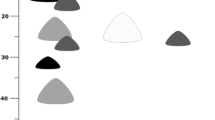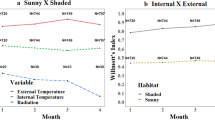Abstract
Some studies require fresh biological material for their development. Ant colonies have been reared under laboratory conditions for scientific purposes, and several methodologies for leafcutter ants have been reported in the literature. However, these methods are not well adapted for rearing basal Attini. In this study, we proposed a methodology for rearing basal Attini species in the laboratory based on the evaluation of colonies of the genus Mycetophylax. The complete system consists of two round translucent polypropylene containers inserted one inside the other, where one serves as a chamber proper and the other as a foraging area. Both containers are sealed with their lids, protecting the environment against desiccation. From a total of 29 colonies collected in the field, 22 colonies survived for at least 30 weeks, and Mycetophylax morschi was the most adapted for rearing under laboratory conditions. The main problem with rearing basal Attini in the laboratory is the loss of moisture. Thus, the method applied here may be adopted for rearing other basal Attini, as well as other ant species very sensitive to moisture variation.

Similar content being viewed by others
References
Bolton B. 2003. Synopsis and classification of Formicidae. Mem. Amer. Ent. Inst. 71: 1–370
Cardoso D.C., Sobrinho T.G. and Schoereder J.H. 2010. Ant community composition and its relationship with phytophysiognomies in a Brazilian Restinga. Insect. Soc. 57: 293–301
Della-Lucia T.M.C. 1993. As Formigas Cortadeiras. Editora Folha de Viçosa. 262 pp
Diehl-Fleig E. and Diehl E. 2007. Nest architecture and colony size of the fungus-growing ant Mycetophylax simplex Emery, 1888 (Formicidae, Attini). Insect. Soc. 54: 242–247
Fernández-Marín H., Zimmerman J.K., Wcislo W.T. and Rehner S.A. 2005. Colony foundation, nest architecture and demography of a basal fungus-growing ant, Mycocepurus smithii (Hymenoptera, Formicidae). J. Nat. Hist. 39: 1735–1743
Himler A.G., Caldera E.J., Baer B.C., Fernández-Marín H. and Mueller U.G. 2009. No sex in fungus-farming ants or their crops. Proc. R. Soc. B 276: 2611–2616
Hölldobler B. and Wilson E.O. 1990. The Ants. Belknap Press of Harvard University Press. 732 pp
Klingenberg C. 2006. Brasilianische Pilzzüchter - Ameisen der Gattung Mycetophylax - Lebensweise und Taxonomie. Doctoral thesis, University of Tübingen, Germany
Klingenberg C. and Brandão C.R.F. 2009. Revision of the fungus-growing ant genera Mycetophylax Emery and Paramycetophylax Kusnezov rev. stat., and description of Kalathomyrmex n. gen. (Formicidae: Myrmicinae: Attini). Zootaxa 25: 1–31
Klingenberg C., Brandão C.R.F. and Engels W. 2007. Primitive nest architecture and small monogynous colonies in basal Attini inhabiting sandy beaches of southern Brazil. Stud. Neotrop. Fauna Environ. 42: 121–126
Lopes B.C. 2005. Recursos vegetais usados por Acromyrmex striatus (Roger) (Hymenoptera, Formicidae) em restinga da Praia da Joaquina, Florianópolis, Santa Catarina, Brasil. Rev. Bras. Zool. 22: 372–382
Lopes B.C. 2007. Foraging ecology of Cyphomyrmex morschi Emery (Hymenoptera, Formicidae) in sand dune vegetation at Southern Brazil. Rev. Bras. Zool. 24: 52–56
Sanhudo C.E.D., Izzo T.J. and Brandão C.R.F. 2008. Parabiosis between basal fungus-growing ants (Formicidae, Attini). Insect. Soc. 55: 296–300
Weber N.A. 1972. Gardening ants, the Attines. Mem. Am. Philos. Soc. 92: 1–146
Weber N.A. 1982. Fungus ants. In: Social Insects, Vol. 4 (Hermann H.R., Ed), Academic Press, New York. pp 255–363
Acknowledgments
Comments by Vivian Sandoval-Gómez and Tathiana Guerra Sobrinho improved this manuscript, and we are grateful also to José Henrique Schoereder for suggestions. We thank Fátima Maria dos Passos Cristiano for help with the field work. Our work was supported by Fundação do Àmparo a Pesquisa do Estado de Minas Gerais—FAPEMIG and Conselho Nacional de Desenvolvimento Científico e Tecnológico—CNPq. Thanks also to Dr. Gareth Cuttle for the English revision of this article.
Author information
Authors and Affiliations
Corresponding author
Rights and permissions
About this article
Cite this article
Cardoso, D.C., Cristiano, M.P. & Tavares, M.G. Methodological remarks on rearing basal Attini ants in the laboratory for biological and evolutionary studies: overview of the genus Mycetophylax . Insect. Soc. 58, 427–430 (2011). https://doi.org/10.1007/s00040-011-0160-3
Received:
Revised:
Accepted:
Published:
Issue Date:
DOI: https://doi.org/10.1007/s00040-011-0160-3




